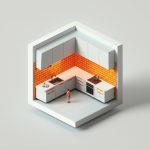Planning to build a house? Getting the floor plan right is the most important step. Instead of wrestling with rulers and graph paper, explore the amazing online tools that make creating professional-looking, builder-ready floor plans easier than ever. This guide compares top software options – like Canva, EdrawMax, and others – so you can pick the perfect one for your needs. We’ll show you what each offers, from the number of templates and ease of use, to pricing and export options. Plus, we’ll share tips and tricks to help you master the software and create stunning plans that will impress any builder. Ready to design your dream home without the headache? Let’s get started! For more free options, check out this list of free floor plan creators.
Builder-Ready Floor Plan Templates: Your Guide to Effortless Design
Dreaming of building your dream home? Or maybe you’re tackling a major renovation? Either way, having the right tools is crucial. Finding the right builder-ready floor plan templates can seem daunting, but it doesn’t have to be. This guide will help you navigate the options and find the perfect software for your project, no matter your skill level. Discover the top tools and learn how to maximize your design potential.
Top Platforms: A Detailed Comparison
Choosing the right software is a bit like picking the perfect vehicle – it depends entirely on your needs. Are you a seasoned design professional, a weekend DIYer, or somewhere in between? Let’s explore some popular options and see what they offer:
We’ll look at four platforms: Canva, EdrawMax, ArcSite, and RoomSketcher. Each has its strengths and weaknesses.
| Feature | Canva | EdrawMax | ArcSite | RoomSketcher |
|---|---|---|---|---|
| Template Library | Huge selection! Tons of styles, easy to find what you need. | Very extensive library; lots of options. | Focuses on professional designs; all are high-quality. | A solid selection, easy to browse. |
| Ease of Use | Super beginner-friendly. Even if you’ve never used design software before, you’ll pick it up quickly. | A bit of a learning curve. It takes some time to master. | Designed to be user-friendly; it plays nicely with mobile devices, too! | Easy peasy – a drag-and-drop interface that’s simple to learn. |
| Customization | Highly customizable. You can really make these templates your own. | Advanced customization is its forte. You can get incredibly detailed. | Provides detailed customization; you can build very precise plans | Outstanding customization options – you’ll have complete control. |
| Export Options | Exports to many different formats and offers high resolution. | Supports a huge variety of formats. | Lots of export options; guaranteed builder-friendly outputs. | Multiple formats, high-resolution output for crisp, clear prints. |
| Collaboration | Basic sharing is easy. | Excellent collaboration features; great for teamwork. | Real-time collaboration is a big plus – perfect for group projects. | Collaborating is seamless; easy to work with others on a project. |
| Pricing | Both free and paid options are available. | Subscription-based. | Offers both subscription and one-time purchase options. | Subscription and one-time purchase options are available. |
Before settling on a platform, consider which aspects are most important for your project for seamless floor plan creation. Different platforms cater to different needs; select the one that aligns with your specific requirements to optimize your workflow.
Finding Your Perfect Match: Asking Key Questions
So, which platform is right for you? To figure that out, ask yourself these questions:
- How tech-savvy am I? Canva is perfect for beginners, while EdrawMax might be better suited for someone with more design experience.
- How big is this project? A small bathroom remodel might be fine with Canva, but a sprawling custom home might need the extra power of EdrawMax or ArcSite.
- What’s my budget? Free options exist, but the more advanced features often come with a price tag.
- Will I be working with others? If you need real-time collaboration, ArcSite is a top contender.
Answering these questions will help guide you toward a floor plan software solution that matches your needs and capabilities. This is like test-driving a car before you buy it, ensuring you get the right fit for your project.
Making Your Templates Shine: Pro Tips and Tricks
After you’ve chosen your software, here are some actionable tips to make your templates stand out:
Step 1: Layering Like a Pro: Think of your design like building with LEGOs – layer by layer. This makes editing easier and keeps everything organized. A well-layered approach can boost efficiency by up to 20%. This is similar to how professional chefs organize their workspace, ensuring everything is easily accessible.
Step 2: Symbol Consistency: Stick to the same symbols throughout your design. Consistency makes the plan look more professional and easier for the builder to understand. Using consistent symbols is like using a common language; it reduces ambiguity.
Step 3: Double-Check Those Dimensions: Accuracy is key! Double (and triple!) check your measurements to ensure everything is perfect for construction. This is crucial for builder-ready plans! Accuracy in dimensions prevents costly construction errors.
Step 4: Clear and Concise Annotations: Add notes and labels to clearly communicate your vision. The clearer your annotations, the smoother construction is likely to be. Clear annotations are like giving your builder a detailed roadmap, avoiding any confusion.
Troubleshooting: Addressing Common Issues
Even experienced designers occasionally run into snags. Here are some common issues and solutions:
- Software acting up? Try restarting the program. If the problem persists, contact customer support – most companies have helpful support teams. This is similar to rebooting your computer when it freezes.
- Export problems? Make sure you’re exporting in a format that your builder’s software will accept. Compatibility is vital. This is like ensuring your document opens correctly on different computers by saving it in a widely-used format.
- Customization challenges? Check the software’s documentation or look for online tutorials. There’s usually a wealth of support available online. This is like consulting a user manual for your car when you can’t figure out a feature.
Ultimately, selecting the right builder-ready floor plan templates and software makes the whole design process less stressful. Take your time, weigh your options, and choose the tool that best fits your needs and skill level. Happy designing!
How to Choose the Best Online Floor Plan Software for Architects and Building Professionals
Key Takeaways:
- Choosing the right floor plan software hinges on your specific needs and project budget.
- Free options exist but often lack crucial features for professional use.
- Factor in template libraries, ease of use, customization, export capabilities, collaboration features, and pricing.
Navigating the Software Landscape: Selection Criteria
So, you’re an architect or building professional looking for online floor plan software. Where do you even begin? The market’s flooded with options, each with unique features. Let’s focus on what truly matters. This guide emphasizes how to choose the best online floor plan software for architects, helping you select the perfect tool for your projects.
We’ll compare several popular platforms, evaluating key features crucial to professional architectural design. This is like comparing different construction tools, focusing on aspects such as durability, functionality, and suitability for specific tasks.
Feature Spotlight: Identifying Key Needs
Here’s a breakdown of the essential features to consider:
- Template Libraries: A robust library of builder-ready templates saves you time. Look for variety in styles and ease of navigation. An extensive template library is like having a well-stocked toolbox at the start of a project.
- Ease of Use: Intuition is key. The software should feel natural, not like navigating a complex maze. User-friendly software can save time and frustration, leading to increased productivity.
- Customization: Can you easily tweak templates to match your client’s vision? Fine-grained control over dimensions, materials, and details is vital. Customization enables you to tailor the designs precisely to your project requirements.
- Export Capabilities: Ensure the software exports in formats compatible with your workflow (e.g., DWG, PDF, etc.) at high resolutions for professional presentations. Compatible export options ensure seamless integration with other tools and processes.
- Collaboration: Sharing and collaborating with clients and contractors is essential. Effective collaboration tools ensure smooth communication and coordination across project teams.
- Advanced Rendering and Visualization: Look for software that offers realistic rendering capabilities, allowing you to create stunning 3D visualizations of your designs.
- Pricing: This is often a deal-breaker. Consider free trials for a test run; compare the cost against the software’s capabilities. Transparent pricing helps you make an informed decision based on your project budget.
Top Contenders: A Detailed Comparison
Let’s compare some leading options:
| Software | Template Library | Ease of Use | Customization | Export Options | Collaboration | Advanced Rendering | Pricing |
|—————|—————–|————-|—————-|—————–|—————-|———————
- Modern Kitchen Backsplash Ideas To Inspire Your Refresh - December 19, 2025
- Modern Backsplash Ideas: A Guide to Todays Kitchen Trends - December 18, 2025
- Ceramic Kitchen Wall Tiles: Style and Protection for Your Walls - December 17, 2025









